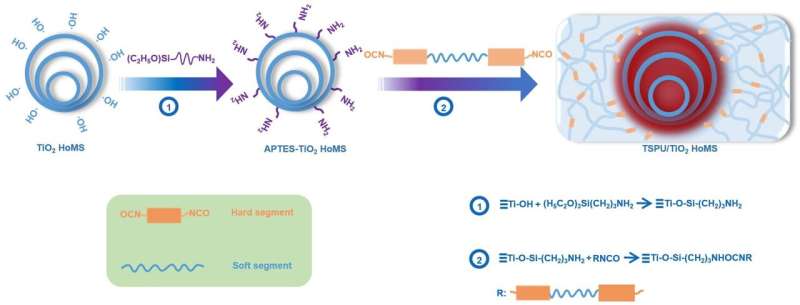
Fabrication process for the smart heat isolator. Credit: Wang Kun
Researchers from Zhengzhou University and the Institute of Process Engineering (IPE) of the Chinese Academy of Sciences have developed a smart material that combines hollow multishelled structure (HoMS) TiO2 and a heat-sensitive polymer in order to automatically control heat transmission.
This study was published in Green Energy & Environment on Jan. 20.
Heat is the most widely used driving force for chemical reactions, but the combustion of fossil fuels leads to huge CO2 emissions. Effective thermal energy management is a key imperative for green production.
Developing an intelligent material that can automatically control heat transfer is a way to limit such emissions. The goal of this intelligent material is to perform thermal insulation at relatively low temperatures while dissipating heat when the reaction system overheats.
"HoMS is assembled from multiple shells and independent closed cavities between shells. It has unique properties of energy transfer and is quite a special structure among all hollow materials," said Prof. Wang Dan from IPE.
The rapid development of HoMS started with the development of sequential templating approach in 2009, and years of study has found it possesses the advantage in effective surface exposure and optimized mass transport.
A hollow structure with multishells can provide more interfaces and thus further inhibit heat convection and transmission, thus making it more favorable for heat isolation, according to Prof. Yang Nailiang.
"The HoMS–polymer composites possess an intelligent thermal insulation behavior and exhibit excellent thermal insulation properties below the given temperature. If the system overheats, the thermal conductivity automatically increases to release the stored energy," said Prof. Du Jiang.
The study shows that the thermally responsive polymer is a promising model for building thermal fields and reveals for the first time the mode of heat transfer through HoMS. This composite exhibits an unusual two-stage endothermic behavior whereby the direction of heat flow in the material matrix changes. The energy is accumulated in HoMS, which operates as a heat reservoir to regulate the thermal flow.
This work provides a new avenue for designing smart reactors for the green chemical industry, thus creating more opportunities for heat-related applications and increasing the potential for efficient energy use.
 Search
Search




 京公网安备110402500047号
京公网安备110402500047号